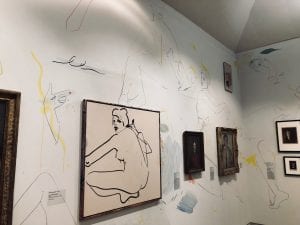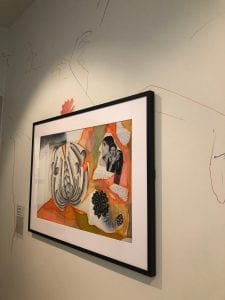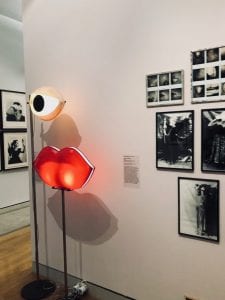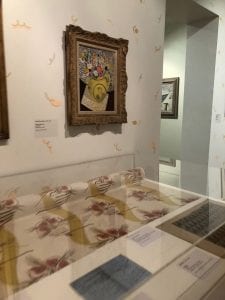
MA History of Design and Material Culture student Paulina Kulacz reviews Pallant House Gallery’s recent Virginia Woolf: an exhibition inspired by her writings
This year marks the centenary of women’s suffrage and thinking through the lens of feminism has been at the forefront for many arts and heritage institutions. All over the country, exhibitions and programmes have tapped into the ethos of women’s rights. So it is perhaps no surprise that this has included exploring the work of Virginia Woolf, whose 1929 book A Room of One’s Own helped shape a voice for creative women, seeking to place them on equal ground with their artistic male counterparts. In A Room of One’s Own, Woolf indicated how women must always keep creating, that in ‘another hundred years … give her a room of her own and five hundred a year, let her speak her mind … and she will write a better book one of these days. She will be a poet’[1]. And almost one hundred years later a new exhibition Virginia Woolf: an exhibition inspired by her writings explored exactly how far female creatives have come and how Woolf’s ideas on feminism have remained relevant to people working across a vast array of media.
The exhibition, curated by Laura Smith, Exhibitions & Displays Curator, Tate St Ives, was a partnership between Tate St. Ives in Cornwall, Pallant House Art Gallery in Chichester and the Fitzwilliam in Cambridge, three locations that were important to Woolf and her writing. Throughout the summer months, the exhibition was at its stop at Pallant House, where I had a chance to see it and to reflect both on my experiences working as a conservation assistant at Monk’s House National Trust and the ways in which one can curate an exhibition around an individual whose work is in a medium that is not often associated with art galleries directly.

Fig. 2: Still Life, The Home and ‘A Room of One’s Own’ section at the Pallant House Art Gallery, including textile art titled Interpret my Dreams by Emma Talbot.
As executive director of the Pallant House Gallery, Simon Martin, stated, ‘rather than it being a biographical exhibition about Virginia Woolf, the show takes her ideas as a structure within which to explore feminist perspectives’[2].Virginia Woolf featured over 80 female artists from 1854 to the present day and tapped into themes present in A Room of One’s Own. One theme I found especially interesting related to one of my favourite quotes from the book, where Woolf indicates that ‘Masterpieces are no single and solitary births; they are the outcome of many years of thinking in common, of thinking by the body of the people, so that the experience of the mass is behind the single voice’[3]. Woolf’s words capture the importance of communal solidarity and thinking through history, but they also capture the importance of fostering relationships, and in Woolf’s case particularly, those amongst women. Virginia Woolf herself cultivated many influential relationships with different women throughout her life, most intimately with her sister the painter Vanessa Bell, but also others such as Dorothy Brett, Dora Carrington, Nina Hamnett, Katherine Mansfield, Gwen Raverat, Vita Sackville-West and Ethel Sands. Pieces by all these women were in the exhibition, and they speak to one another both directly and indirectly about shared ideas and passions.

Fig. 3: Abstract bodies painted directly on the gallery walls by France-Lise McGurn at the Pallant House Art Gallery.
Juxtaposing these pieces were works by contemporary artists such as Judy Chicago, Carol Bove, Linder, Louise Bourgeois, and newly commissioned works by France-Lise McGurn, who painted abstract figures directly onto the walls of the gallery – a homage to the Bloomsbury spirit of painting on things. Together, all these works drew on Woolf’s feminist perspectives. They connected tangibly, anecdotally, geographically or even conceptually to her. They depicted how the themes present in Woolf’s work, such as identity, domesticity and landscape, have resonated with artists across time through their shared experience; how, like Woolf, these artists have also explored notions of gender and different ways of experiencing and identifying as female.

Fig. 4: Study for Virginia Woolf – from ‘The Dinner Party’ by Judy Chicago at the entrance of the exhibition Virginia Woolf: an exhibition inspired by her writings.
Divided into eight rooms the exhibition featured over fifty works of photography, film, painting, sculpture, wood carving, letters, books, and even material culture, such as a tea set used by Virginia herself and painted by her sister. It also featured objects such as Suffragette memorabilia and letters from Eleanor Marx, pieces extremely interesting on their own, but lost in a whirlwind of many other works that had a more dominating effect and a more direct link to the themes and to Woolf herself. At times it seemed there were too many pieces, too many artists, too many directions and links attempted in the themes explored. It made the exhibition slightly overwhelming. Perhaps one could argue this is how one feels when reading a work by Virginia Woolf – where words, metaphors and the images evoked fold into one another with little room to breath – and that this was reiterated in the exhibition. Still, the experience of reading an overwhelming book is different from stepping into an overwhelming gallery space. Time moves differently in galleries and the multi-sensory experiences are more complicatedly haphazard. There simply is more is at stake and this is where Virginia Woolf potentially misses the mark. It was an interesting exhibition to see, and one I enjoyed, but it could have been just as strong with a little less to take in.

Fig. 5: Section of the exhibition featuring Nicola L’s plastic eye and lip lamps and Birgit Jürgenssen’s 10 days – 100 photos composition.
Virginia Woolf: an exhibition inspired by her writings is currently showing at its final stop at The Fitzwilliam Museum, Cambridge until 9th December 2018.

Fig. 6: Still Life, The Home and ‘A Room of One’s Own’ section at the Pallant House Art Gallery, featuring work by Vanessa Bell and Jane Simone Bussy.
[1]Virginia Woolf, A Room of One’s Own (London: Granada Publishing Limited, 1977) 89-90.
